ICC match referee Madugalle rates the Rawalpindi pitch as below average, citing a lack of challenge for bowlers and dominance by batsmen. The pitch's imbalance favored batsmen, attracting one demerit point from the ICC. This assessment influences future matches at the venue, prompting authorities to focus on enhancing pitch conditions. Player reactions reflect dissatisfaction with the unresponsive surface, prompting necessary adjustments in gameplay strategies. The importance of consistent pitch quality for competitiveness is paramount. Madugalle's rating highlights the need for pitch improvements to uphold game integrity. Understanding the implications of this assessment can provide valuable insights into the ongoing pitch quality debate.
Key Takeaways
- Rawalpindi pitch rated below average by ICC match referee Madugalle.
- Lack of challenge for bowlers and dominance by batsmen influenced the rating.
- Pitch received one demerit point from the ICC.
- Insufficient assistance to bowlers led to imbalance favoring batsmen.
- Pitch lacked characteristics for an engaging game between bat and ball.
Rawalpindi Pitch Rating Explanation
ICC match referee Madugalle explained the below-average rating of the Rawalpindi pitch due to its lack of challenge for bowlers and dominance by batsmen. The pitch's unresponsive nature led to it receiving one demerit point from the ICC. Madugalle highlighted that the pitch didn't provide enough assistance to bowlers, resulting in an imbalance favoring batsmen during the match. He stated, 'The Rawalpindi pitch lacked the usual characteristics that contribute to an engaging and competitive game between bat and ball.' This assessment aligns with the ICC's guidelines, which aim to secure fair playing conditions that offer a balance between batting and bowling capabilities.
The demerit point issued to the Rawalpindi pitch serves as a warning, as accumulating five demerit points could lead to severe penalties, including a suspension from hosting international cricket for up to a year. Despite falling short of the thresholds for harsher penalties, the below-average rating indicates a need for improvement to enhance the overall quality and competitiveness of matches held on the Rawalpindi pitch.
Impact of Below Average Rating
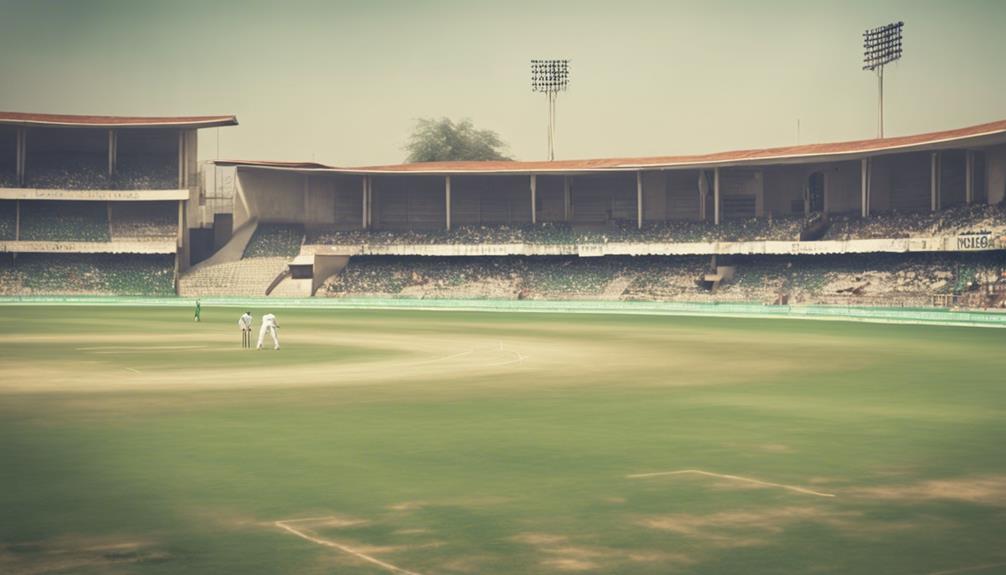
Critically evaluating the Rawalpindi pitch, Madugalle underscored its deficiency in offering a competitive environment for bowlers. The below average pitch rating resulted in the venue receiving one demerit point from the ICC, reflecting concerns about the lack of balance between bat and ball. This rating is important as it not only impacts the current match but also influences future matches at the ground. The focus now shifts towards implementing necessary pitch quality improvements to address the issues highlighted by the assessment. Ground authorities will likely work on enhancing the pitch conditions to guarantee a fair contest between bat and ball in upcoming games. The impact of this rating serves as a wake-up call for groundsmen to prioritize maintaining a standard that supports a balanced competition. Below is a table summarizing the potential impact of the below average pitch rating:
| Impact of Below Average Rating | ||
|---|---|---|
| Future matches at the venue may be affected | Potential improvements in pitch quality | Emphasis on maintaining balance between bat and ball |
Lack of Batting-Bowling Balance

Madugalle's observation of the Rawalpindi pitch highlighted a significant lack of equilibrium between batting and bowling opportunities, favoring the former over the latter.
This imbalance heavily influenced player performance, leading to high-scoring draws that raised concerns about the pitch's fairness and competitiveness.
It's evident that improvements are necessary to address the unfavorable conditions that hinder the balance between batting and bowling on the Rawalpindi pitch.
Unfavorable Pitch Conditions
The Rawalpindi pitch's bias towards batsmen undermined the balance between batting and bowling, resulting in uncompetitive high-scoring draws. Match referee Madugalle highlighted the below-average rating of the Rawalpindi pitch, emphasizing the imbalance between bat and ball during the Test match.
This lack of assistance for bowlers on the flat and lifeless pitch raised concerns about the competitiveness and integrity of Test cricket. The accumulation of demerit points for poor pitches is a serious matter as it can lead to venue suspensions, underscoring the significance of maintaining pitch quality.
The unfavorable pitch conditions not only impacted the on-field action by favoring batsmen but also brought into question the fairness and excitement of the game. Addressing the issues with the Rawalpindi pitch is essential to ensure a more balanced contest between bat and ball, preserving the essence of Test cricket and upholding its standards.
Impact on Player Performance
Player performance was greatly impacted by the lack of balance between batting and bowling on the Rawalpindi pitch during the Pakistan vs. Australia Test. The below-average rating of the pitch led to an evident struggle for bowlers to make an impact, as only 14 wickets fell throughout the match. The flat and lifeless nature of the pitch heavily favored the batsmen, offering minimal assistance to the bowlers.
Match referee Madugalle highlighted the pitch's inability to provide a fair contest between bat and ball, emphasizing the unresponsive surface's impact on the dynamics of the game. The pitch conditions notably influenced player performance, tipping the scales towards the batsmen and creating an imbalance in the traditional battle between bat and ball.
The lack of assistance for bowlers on the below-average pitch challenged their effectiveness, leading to a scenario where batting dominance overshadowed the bowlers' contributions, ultimately affecting the overall competitive nature of the Test match.
Need for Pitch Improvement
Improving the balance between batting and bowling on the Rawalpindi pitch is essential for enhancing the overall competitiveness of Test matches. The recent high-scoring Test match where 1187 runs were scored for just 14 wickets over five days has raised concerns about the fairness of the pitch.
The lifeless pitch heavily favored the batsmen, making it challenging for bowlers to have a significant impact. ICC Match Referee Madugalle's assessment underlines the substantial imbalance between bat and ball during the game. The lack of assistance for bowlers has led to calls for pitch improvement to guarantee a more even contest between bat and ball.
The dominance of batsmen on such pitches not only diminishes the excitement for fans but also questions the integrity of the game. Addressing the issues of the pitch's nature is vital to maintain the essence of Test cricket and provide a fair platform for both batsmen and bowlers to showcase their skills.
Implications for Future Matches
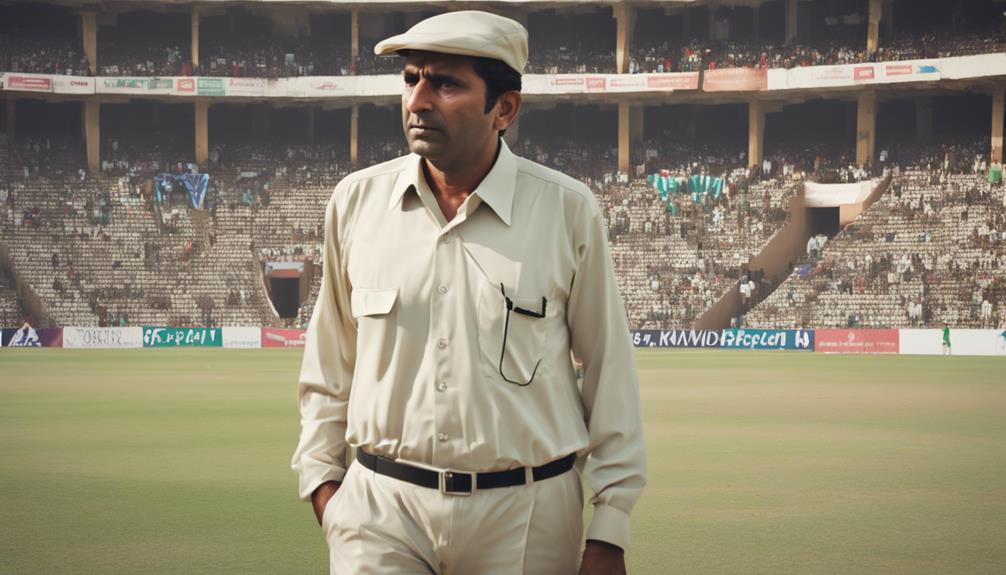
With Madugalle's below average rating of the Rawalpindi pitch, future matches at the venue may require teams to adjust their strategies accordingly. The pitch quality standards set by the evaluation could influence how teams approach their gameplay in upcoming fixtures.
Teams participating in matches at Rawalpindi will likely need to adapt their tactics based on the assessment of the pitch. The below average rating underscores the significance of maintaining consistent pitch quality to uphold the competitiveness and fairness of cricket. It highlights the necessity for ensuring that the pitches meet the required standards for a level playing field.
As Madugalle's assessment emphasizes the importance of consistent pitch quality, it becomes apparent that improvements in pitch preparation may be necessary to meet the expectations of competitive cricket. Future matches at Rawalpindi will likely see teams strategizing differently to cope with the challenges posed by the current pitch conditions.
Concerns Over Pitch Quality
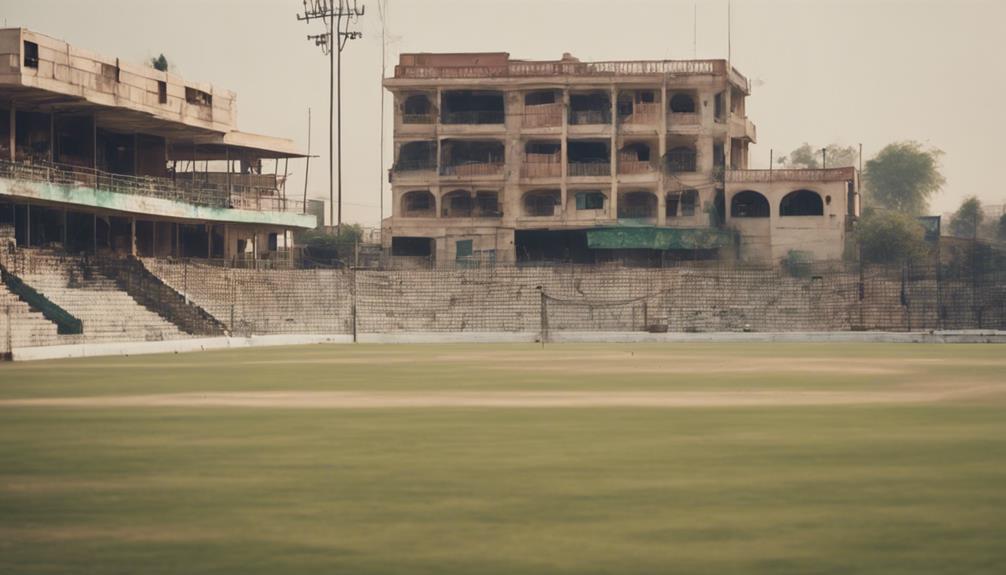
The below-average rating given by ICC match referee Ranjan Madugalle to the Rawalpindi pitch in the Australia vs. Pakistan Test has raised concerns about the quality of the playing surface.
The imbalance favoring batsmen over bowlers could impact player performance and the overall competitiveness of future matches at the venue.
Madugalle's evaluation is part of the ICC's Pitch Monitoring Process, aiming to guarantee fair playing conditions for all teams involved.
Pitch Conditions Criticized
Concerns have been raised over the pitch quality at Rawalpindi, as ICC match referee Madugalle rated it below average due to its lifeless nature. The lack of assistance for bowlers on the flat pitch has been criticized, with Madugalle noting the imbalance in favor of batsmen, leading to high-scoring draws.
The pitch's quality has been questioned for not providing an even contest between bat and ball, raising doubts about its suitability for international matches. If the issues persist, the accumulation of demerit points could potentially result in the suspension of the venue from hosting such games.
Teams and players are likely to face challenges adapting to the conditions on a pitch that offers little help to bowlers, potentially impacting the competitiveness of matches held at Rawalpindi. The concerns highlighted by the ICC match referee shed light on the importance of maintaining balanced pitch conditions to ensure equitable gameplay and engaging contests.
Impact on Players
Players like Pat Cummins and Steve Smith expressed dissatisfaction with the Rawalpindi pitch, highlighting its lifeless nature and lack of challenge. The pitch's character, or lack thereof, was evident in the mere 14 wickets that fell over five days, sparking concerns about the balance between bat and ball.
This imbalance affected players' adaptability, compelling them to adjust their strategies to cope with the pitch's unresponsiveness. The competitiveness of the match was also significantly impacted, as the pitch didn't offer much to bowlers, shifting the dynamics in favor of batsmen.
PCB Chairman Ramiz Raja defended the pitch but acknowledged the necessity for improvements to elevate the pitch quality. The below-average rating given by ICC Match Referee Madugalle shed light on the significant influence the pitch had on the players and the overall game.
This scrutiny emphasizes the importance of maintaining a pitch that challenges players while ensuring a fair contest between bat and ball.
Need for Pitch Improvement

Acknowledging the imperative for pitch enhancement, PCB Chairman Ramiz Raja has indicated a pressing need for improvements following the ICC match referee's critique of the Rawalpindi pitch. The below-average rating and the demerit point issued highlight the necessity for immediate action to address the pitch's shortcomings.
Raja emphasized the importance of providing challenging and fair playing conditions for both teams. The lack of character and difficulty faced by players on the Rawalpindi pitch have been noted by officials and players alike, underscoring the urgency for enhancements.
Raja stated, 'It is essential to maintain high-quality pitches to uphold the integrity of the game and establish a level playing field.' The criticism following the recent Test match between Australia and Pakistan serves as a clear indication that improvements are vital to prevent similar issues in the future.
The PCB is now tasked with implementing measures to enhance the pitch quality to meet international standards and promote competitive cricket.
International Match Fairness

Highlighting the significance of pitch quality in maintaining fairness and competitiveness in international matches, ICC match referee Madugalle rated the Rawalpindi pitch as below average after the recent Test match between Pakistan and Australia. This below-average rating led to the venue receiving one demerit point under the ICC Pitch Monitoring Process.
Madugalle's assessment raised concerns about how the pitch could affect the balance and fairness of matches played there. The match referee's rating emphasizes the vital role of high pitch standards in ensuring fair play and promoting competitive cricket.
Evaluations like these shed light on the importance of pitch quality in influencing match outcomes and player performances on the international stage. Such assessments contribute to upholding the integrity of the game and creating a level playing field for teams competing in various cricket tournaments worldwide.
One Demerit Point Consequences
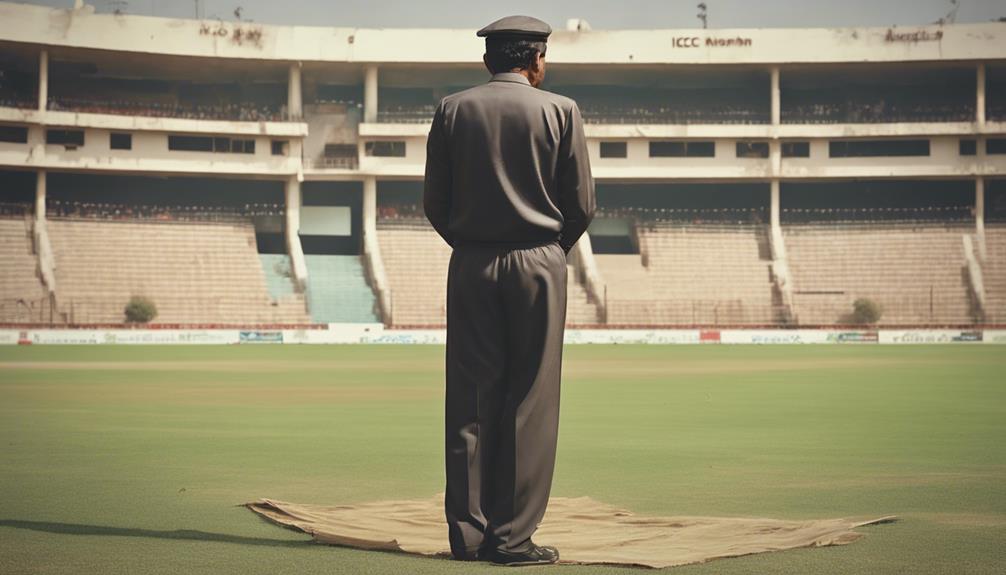
The issuance of one demerit point due to Madugalle's below-average rating of the Rawalpindi pitch signifies consequences for the venue's lack of quality and performance standards. According to ICC guidelines, accumulating demerit points can lead to serious penalties. If a venue accumulates five demerit points, it could face a year-long suspension from hosting international cricket matches. The Rawalpindi pitch narrowly avoided a harsher penalty of three or five demerit points, highlighting the severity of the situation. This one demerit point serves as a warning sign that improvements are necessary to meet the required quality standards set by the ICC.
| Consequences of One Demerit Point |
|---|
| Potential suspension from hosting international matches |
| Warning to improve pitch quality and performance standards |
| Emphasis on following ICC guidelines for future matches |
Player Reactions to Pitch

David Warner expressed concerns about the quality of the Rawalpindi pitch during the Pakistan vs. Australia Test, hoping for improvements in the upcoming Karachi Test.
In contrast, Imam-ul-Haq defended the pitch, emphasizing its fair playing conditions for both teams and highlighting the challenges posed by weather interruptions.
The differing player reactions underscore the impact the pitch quality can have on gameplay and the varying perspectives on the need for enhancements.
Player Concerns About Pitch
Imam-ul-Haq defended the Rawalpindi pitch, arguing that it offered fair playing conditions for both teams. Despite player concerns, he emphasized the need to adapt to the pitch and play to Pakistan's strengths as hosts.
This comes in light of referee Ranjan Madugalle's assessment, which rated the Rawalpindi pitch as below average, resulting in demerit points. However, David Warner expressed dissatisfaction, criticizing the pitch for not providing enough assistance to bowlers.
The player reactions are crucial, especially considering this marked Australia's first tour to Pakistan since 1998. Imam-ul-Haq highlighted the challenges faced due to weather interruptions on the pitch, impacting gameplay and missed opportunities for both teams.
As the debate on the pitch conditions continues, the focus remains on addressing player concerns while also acknowledging the importance of adapting to the playing conditions for a fair competition.
Impact on Gameplay
Despite criticisms from players like David Warner and Imam-ul-Haq, the Rawalpindi pitch has sparked debate due to its impact on gameplay during the recent Pakistan vs. Australia Test match. Player reactions to the pitch highlighted concerns about the fairness of the contest between bat and ball.
Warner criticized the substandard pitch for not providing an even playing field, while Imam-ul-Haq defended it, emphasizing the equal conditions it offered both teams. The pitch's impact on gameplay was evident as teams struggled to adapt to the challenging conditions.
Warner's hope for an improved pitch in Karachi reflects the desire for a more competitive environment in the upcoming matches. The ICC's assessment, as conveyed by the match referee Madugalle, will be pivotal in determining the suitability of the Rawalpindi pitch for future matches.
The need for pitches to support fair play and maintain the competitive spirit of the game is paramount in ensuring a balanced and engaging cricketing experience for all teams involved.
Calls for Improvement
The contrasting perspectives on the Rawalpindi pitch during the recent Pakistan vs. Australia Test have sparked discussions among players regarding the necessity for improvement.
- David Warner criticized the Rawalpindi pitch for its lifeless nature, raising concerns about its influence on the match outcome.
- Imam-ul-Haq defended the pitch, arguing that it provided equal conditions for both teams and emphasized playing to Pakistan's strengths as hosts.
- Imam-ul-Haq highlighted missed opportunities due to weather interruptions impacting the pitch's effect on the game.
- The player perspectives on the Rawalpindi pitch have fueled the ongoing debate on pitch quality and its significant role in determining match outcomes.
The diverging opinions from players like Warner and Imam-ul-Haq underscore the importance of addressing concerns about pitch quality to maintain fair gameplay conditions and avoid controversies surrounding match results. The debate on the Rawalpindi pitch continues as players advocate for improvements to enhance the overall quality of cricket matches held on such surfaces.
ICC's Evaluation Criteria
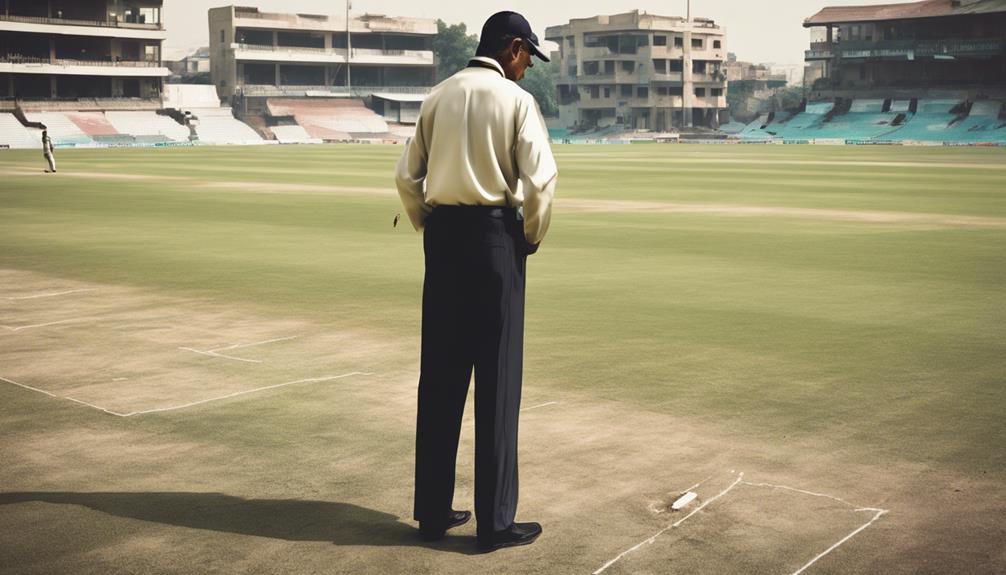
During the evaluation process, ICC assesses pitches based on specific criteria to maintain high standards of quality and fairness. As part of the ICC Pitch Monitoring Process, match referee Ranjan Madugalle rated the Rawalpindi pitch as below average during the Pakistan vs. Australia Test match. This assessment resulted in the pitch receiving one demerit point from the ICC.
Madugalle's evaluation highlighted concerns regarding the pitch's lack of character and the limited challenge it presented to the players. The below average rating raises questions about the pitch's suitability for future matches at the venue and underscores the importance of complying with high pitch standards set by the ICC.
Frequently Asked Questions
What Happened to Rawalpindi Pitch?
The Rawalpindi pitch faced criticism for its below-average quality during a recent Test match. The lack of balance between bat and ball led to ICC match referee Madugalle giving the pitch a demerit point.
This assessment points to the need for significant improvements in pitch conditions. This rating might impact Rawalpindi's future as an international match venue.
How Do You Rate a Cricket Pitch?
When evaluating a cricket pitch, match referees like ICC's Madugalle assess factors like bounce, turn, and carry to determine its quality.
Their evaluations impact bowlers, batsmen, and the overall competitiveness of the game.
Referees follow a structured system to rate pitches as below average, poor, or unfit, assigning demerit points accordingly.
The goal is to maintain a fair balance between bat and ball, promoting exciting and competitive matches.
Conclusion
To summarize, the ICC match referee Madugalle has rated the Rawalpindi pitch as below average, raising concerns about the fairness of international matches played on such surfaces. This rating could have implications for future games, as player reactions to the pitch conditions may impact their performance.
As the old adage goes, 'you reap what you sow,' highlighting the importance of maintaining high-quality playing conditions to guarantee a level playing field for all teams.










